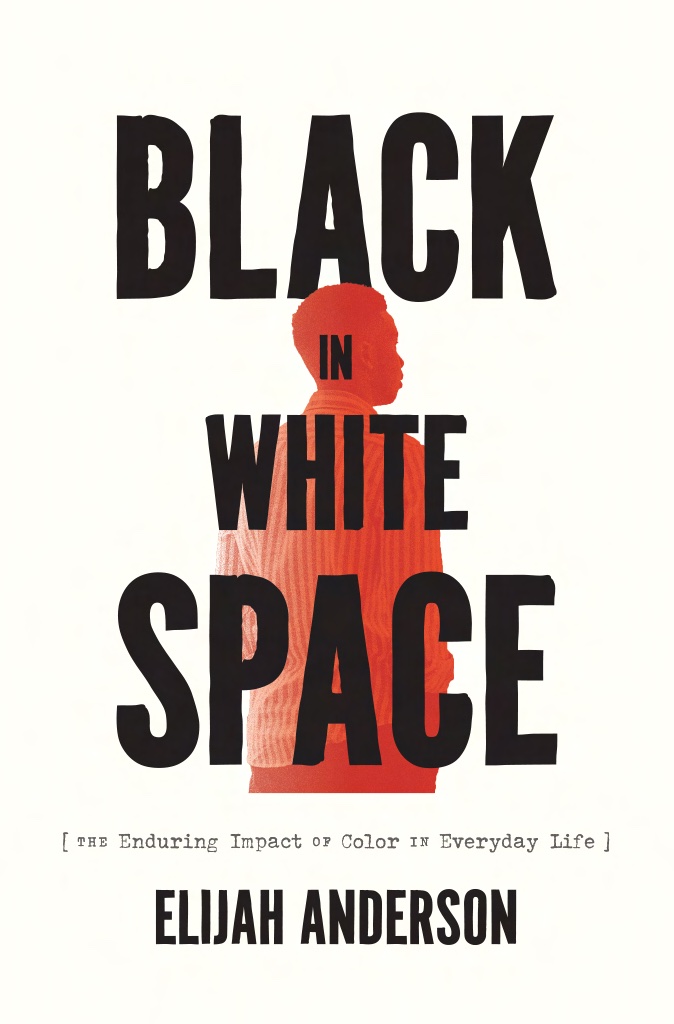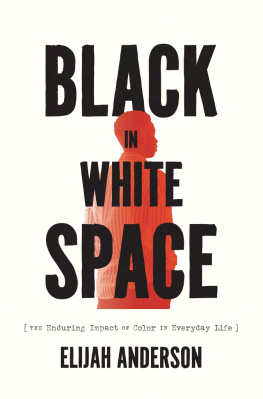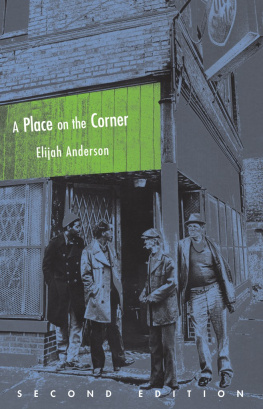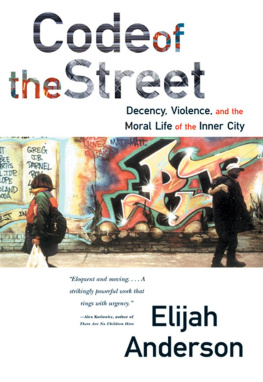
Black in White Space
Black in White Space
The Enduring Impact of Color in Everyday Life
The University of Chicago Press Chicago and London
The University of Chicago Press, Chicago 60637
The University of Chicago Press, Ltd., London
2022 by The University of Chicago
All rights reserved. No part of this book may be used or reproduced in any manner whatsoever without written permission, except in the case of brief quotations in critical articles and reviews. For more information, contact the University of Chicago Press, 1427 E. 60th St., Chicago, IL 60637.
Published 2022
Printed in the United States of America
31 30 29 28 27 26 25 24 23 22 1 2 3 4 5
ISBN-13: 978-0-226-65723-3 (cloth)
ISBN-13: 978-0-226-81517-6 (e-book)
DOI: https://doi.org/10.7208/chicago/9780226815176.001.0001
Library of Congress Cataloging-in-Publication Data
Names: Anderson, Elijah, author.
Title: Black in white space : the enduring impact of color in everyday life / Elijah Anderson.
Description: Chicago : University of Chicago Press, 2022. | Includes bibliographical references and index.
Identifiers: LCCN 2021021095 | ISBN 9780226657233 (cloth) | ISBN 9780226815176 (ebook)
Subjects: LCSH: African AmericansUnited StatesSocial conditions. | RacismUnited States.
Classification: LCC E185.86 .A525 2021 | DDC 305.896/073dc23
LC record available at https://lccn.loc.gov/2021021095
 This paper meets the requirements of ANSI/NISO Z39.48-1992 (Permanence of Paper).
This paper meets the requirements of ANSI/NISO Z39.48-1992 (Permanence of Paper).
This book is dedicated to the memory of my mother, Carrie Bell Hull, who taught me everything I knowand encouraged me every day to be somebodyto my grandchildren, Eve, Isaiah, Arturo, and Soleil, who teach me new lessons every dayand to my wife and best friend, Nancy Anderson, who has supported me unfailingly in every way.
Contents
I want to take this opportunity to acknowledge and thank my research subjectsespecially the people of Philadelphia, who were so forthcoming with their observations and their stories about their issues with color. Id also like to thank the following friends and colleagues, who provided me with support, feedback, and helpful comments from time to time, and who helped me in all sorts of ways.
In no particular order, I note them here as follows: Stephane Andrade, Scott Brooks, James Kurth, Waverly Duck, Richard Alba, Gerald Jaynes, Fred Block, Alvaro Sanchez, Julia Adams, Jeffrey Alexander, Kalfani Tur, Gregory Squires, Jack Katz, Zsuzsa Berend, Vida Bacj, Michael Deland, Randall Sims, Vincent Calloway, Russell Crockett, Angela Crockett, Duke Austin, Vani Kulkarni, Craig Holloway, Philip Weinstein, William Frucht, Marcus Hunter, Nikki Jones, Harold Bershady, Bill Kornblum, Victor Lidz, Annikki Herranen-Tabibi, Randall Collins, Deborah McGill, Linda Haapajrvi, Oliver St. Clair Franklin, William Whitworth, Herman Hawthorne, Marlese Durr, Joe Feagin, Vernon Clark, Anthony Andrews, Lynwood Pettie, Fred Wherry, Bob Washington, Arthur Paris, Grey Osterud, the late Acel Moore, Linda Wright Moore, Fred Wiemer, Reynolds Farley, Waldo Johnson, Rourke OBrien, Leighton Hull, Howard S. Becker, and my dear friend, the late Rene C. Fox.
For research assistance, I want to thank James Finley, Rasmus Schlutter, Rachel Beshevkin, and Shanti Fader. And I thank my editors at the University of Chicago Press, the late Douglas Mitchell, Alice Bennett, Erin DeWitt, and Elizabeth Branch Dyson.
And last but not least, I want to acknowledge my children, Caitlin Anderson and Luke Anderson; their spouses, Jorge Contreras and Brenna Anderson; and my wife, Nancyall of whom listened patiently and served as a sounding board around the dinner table. Without the help and assistance of all these folks, and especially the people of Philadelphia, this book would not be what it is.
Earlier versions of some parts of this book have been published in the Atlantic Monthly, the Annals of the American Academy of Political and Social Science, the Washington Monthly, the Guardian, the Sociology of Race and Ethnicity, and Vox. This work, including the representation of certain scenes, is based on qualitative fieldwork, including observations and interviews, and firsthand accounts over the course of many years. To protect the privacy and the confidentiality of my subjects, names and certain details have been disguised.
When Supreme Court Chief Justice Roger B. Taney declared in the 1857 Dred Scott decision that the framers of the Constitution believed Black people had no rights which the white man was bound to respect, he ruled on the state of American society at that time: Black people, free or enslaved, held a place inferior to that of White people, and all White people were above all Black people. This ruling established and reinforced the societal prejudice that White people were simply better than Black people by virtue of being White (Painter 2010; Franklin and Higginbotham [1947] 2021).
After Emancipation, as Black people migrated to towns and cities in the North and in the South, their stigmatized place both followed and preceded them. When Black people settled in their new communities, their reception was decidedly mixed; they were resisted and tolerated, and as their numbers grew relentlessly, the local White people worked to contain them, at times violently, in what became the Black section of town. These settings where Blacks were relegated were the precursors of the Black ghettos that have proliferated throughout the nation since that time, settings that symbolically reinforced what slavery established: the lowly place of Black people in the public mindset.
Now, in virtually every city in America, there is a Black side of town, an area where Black people are concentrated, which is generally apart from White residential areas. But the ghetto is not solely a matter of physical location; it is also a symbol of the ghettos peculiar relationship with the wider White community. In the past, the Black ghetto served as a haven from racism, a place of refuge where Black people could feel at home among their own kind. These neighborhoods developed as segregated communities, replete with their own infrastructures and social organization. In time, they would take on a more sinister definition and purposenot just for Blacks but for the wider society as well. Eventually, the ghetto would serve as a place reminiscent of a reservation, where Black people would reside.
Eventually, the White population developed and elaborated their own sense of group position in contradistinction to the place of Black people, symbolism manifested in the physical space of the Black ghetto. Thus, in the minds of the White majority, and for Black people as well, the ghetto became a fixture of mental as well as physical space. Each generation of White people became socially invested in the lowly status of Black people; they understood their own racial identity in terms of whom they opposed, and this positionality was institutionalized, passed on from one racist generation to the next, and manifested through the enduring principle of White over Black.
The urban ghettos of America continue to struggle with a legacy of racial caste. Now buffeted by the winds of deindustrialization and a global economy that has left them disenfranchised and socially excluded, these poor Black communities are characterized by high rates of structural poverty and joblessness. Incivility, crime, and violence are all too common. For successful Blacks, who have made their way into the upper reaches of the larger society, but who share the phenotype and skin color of those left behind, contradictions and dilemmas of status abound, as they are at times confused with Black people of the ghetto, whom many White people, and especially the police, are inclined to view and treat as outcasts.
Next page










 This paper meets the requirements of ANSI/NISO Z39.48-1992 (Permanence of Paper).
This paper meets the requirements of ANSI/NISO Z39.48-1992 (Permanence of Paper).